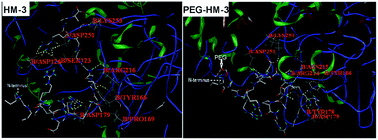PEGylated HM-3 presents anti-rheumatic bioactivity by inhibiting angiogenesis and inflammation
Abstract
PEGylation improves the pharmacokinetic and pharmacodynamic properties of polypeptide drugs. After PEGylation, the modified HM-3 (PEG-HM-3) exhibited a prolonged half-life in blood. In this paper, we evaluated the anti-rheumatic effect of PEG-HM-3, and investigated the target for angiogenesis and inflammation. The anti-rheumatic activity of PEG-HM-3 was documented in an adjuvant-induced arthritis (AIA) model. PEG-HM-3 significantly decreased the paw increase percentage and clinical scores, inhibited characteristic signs such as synovial hyperplasia, pannus formation, inflammatory infiltration and bone erosion in histological analysis, and reduced bone erosion with the X-ray analysis of the hint paws of rats. The target for angiogenesis and inflammation was assessed with in vivo and in vitro techniques. The in vivo experiments confirmed that PEG-HM-3 decreased the number of blood vessels in rheumatic synovium, reduced the level of serum anti-CII autoantibodies, and decreased the levels of synovial TNF-alpha and VEGF in a collagen-induced arthritis (CIA) model. The in vitro results confirmed that the anti-angiogenic effect of PEG-HM-3 was mainly achieved through the inhibition of HUVEC migration. PEG-HM-3 inhibited the mitotic effects in the T-cell population. PEG-HM-3 could significantly inhibit the TNF-alpha and VEGF levels in the LPS-stimulated macrophage and the latter effect was stronger than that seen with HM-3. Furthermore, the simulated molecule docking result showed that the RGD motif of PEG-HM-3 inserted into the pocket site of integrin αvβ3, and PEG-HM-3 had a higher predicted affinity with integrin αvβ3 compared to the predicted affinity of HM-3 and integrin αvβ3. This study has uncovered that PEGylate HM-3 could present an anti-rheumatic bioactivity with a less frequent schedule, and PEG-HM-3 exhibited its anti-rheumatic effects by inhibiting angiogenesis and inflammation. Furthermore, the main targeting site has been confirmed, which explained the changes in the bioactivity of PEG-HM-3.


 Please wait while we load your content...
Please wait while we load your content...